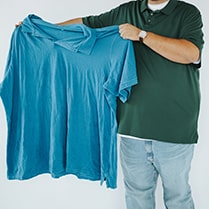
With any surgical operation comes risks, such as a leak, bleeding, blood clots, and, in the case of post-bariatric patients, anastomotic strictures after weight loss surgery. An anastomotic stricture occurs in post-op bariatric patients when the connection between the stomach and esophagus narrows.
Symptoms of strictures after weight loss surgery include nausea, vomiting, trouble swallowing, feeling fullness in the upper-middle abdomen, and trouble eating certain foods. Although it is not particularly clear why strictures form, it is believed to be caused by the use of staples rather than stitches, scarring, lack of blood flow to the surgery site, and ulcers at the anastomosis resulting from smoking or taking NSAIDs.
Strictures are not life-threatening but can cause discomfort, mainly when eating. Typically, symptoms of a stricture will present themselves around a month after your bariatric procedure but can also begin to cause problems up to 6 months post-op.
Strictures after the Gastric Sleeve
The gastric sleeve has the potential to cause a stricture due to the alternation of the stomach size and shape. The gastric sleeve removes about 70% of the stomach and leaves behind a long, narrow stomach tube. Occasionally, that long stomach can shift and cause a kink—think of a garden hose—preventing the movement of stomach contents from flowing smoothly through your digestive tract.
Typically, these symptoms will present themselves about six months post-op. Generally, patients will find eating more challenging, potentially experiencing more reflux and vomiting after eating.
Strictures after the Gastric Bypass
Patients with a gastric bypass are also likely to develop a stricture, but for other reasons. The gastric bypass operation creates a small gastric pouch, about the size of an egg, and forms a new connection between the small bowel and this new pouch. We connect the small bowel to the gastric pouch with either sutures or staples.
As that area of connection begins to heal, the opening between the pouch and intestines may become more narrow in some patients. Generally, when a patient complains of feeling like food is getting stuck, or they are throwing up, we immediately assume it is an anastomotic stricture. An anastomotic stricture after gastric bypass is the most common complication. "Near 60% [of patients] present a mild stricture (with a diameter between 7 and 9 mm), [with] 28% asymptomatic. This complication is easily treated by endoscopic procedure if it is diagnosed early (3 to 4 weeks) after surgery. Routine endoscopy 1 month after surgery is the only objective scientific way to determine the real true incidence of this complication."
Diagnosing Strictures after Weight Loss Surgery
There are several ways to diagnose strictures after weight loss surgery, including radiographically or with an upper GI. In diagnosing radiographically, we will have a patient drink a contrast and then watch the contrast move through the patient’s digestive tract via a radiology machine. If the patient has a stricture, we will often see the contrast slow or get stuck at the top of the stomach.
Another way in which we can diagnose a stricture is through an upper endoscopy. We will slide a scope down into the esophagus and stomach to see if there is any place where the stomach is kinked or if the connection points are too narrow. If we find any signs of a stricture, we can sometimes fix it by sliding a balloon down through the scope to stretch out the area.
In most cases, the balloon will fix the issue; however, there are some instances where the narrowing is too extreme, and we can’t get the balloon to open enough to stretch out the stricture. In this case, we may recommend additional surgery to convert the gastric sleeve to a gastric bypass. During this operation, we will divide the stomach above the narrowed section and use that as the new gastric pouch, bringing the small bowel up to meet the new pouch. This will almost always fix the issue of the stricture.
Gastric sleeve and gastric bypass patients both have the same risk of developing strictures after weight loss surgery. However, a stricture is more easily managed in gastric bypass patients via an upper endoscopy. Nonetheless, there are pros and cons to both operations. If you are experiencing any issues that could be symptomatic of a stricture, we recommend you schedule an appointment with your bariatric care team to be appropriately evaluated.












